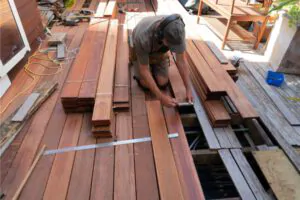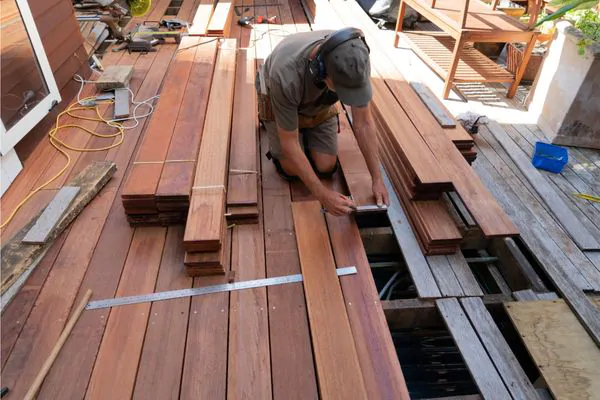Are you dreaming of a new deck but worried about the cost? You’re not alone. Many homeowners want to know: What is the cheapest way to build a deck? Building a deck can be pricey, but it doesn’t have to break the bank.
Did you know that DIY deck construction can save you thousands? A pro job might cost $6,000 to $8,000, while doing it yourself could run under $900 for materials. This blog post will show you how to build a budget-friendly deck without skimping on quality.
We’ll cover simple designs, affordable materials, and money-saving tips. Ready to start your outdoor project?
Key Takeaways
- DIY deck construction can save thousands, with materials costing under $900 compared to $6,000-$8,000 for professional installation.
- Simple rectangular designs using pressure-treated wood and concrete footings offer the most cost-effective approach for budget decks.
- Concrete deck blocks measuring 7-3/4 in. x 10-3/4 in. x 10-3/4 in. provide a cheap foundation option without needing costly footings.
- Buying materials during off-season sales and doing the installation yourself can significantly reduce overall deck costs.
- Home Depot offers project planning assistance at 1-888-824-5316 for DIYers tackling deck construction for the first time.
Planning Your Budget Deck
Planning a budget deck starts with smart choices. You can save money by keeping your design simple and picking affordable materials.
Keep the design simple
Simplicity reigns supreme in budget-friendly deck design. A basic rectangular shape maximizes standard lumber lengths and minimizes waste. This approach cuts down on material costs and installation time.
Straightforward designs also reduce the complexity of cuts and joints, making the project more DIY-friendly.
Concrete footings provide a sturdy foundation without breaking the bank. They’re easy to install and offer excellent stability for your deck. Opting for pressure-treated wood as your primary material balances affordability with durability.
It resists rot and insect damage, extending the life of your outdoor space.
The best design is the simplest one that works. – Albert Einstein
I’ve found that keeping deck plans uncomplicated leads to fewer headaches during construction. My first DIY deck project taught me the value of straightforward layouts. It allowed me to focus on proper technique rather than intricate details.
This approach resulted in a solid, functional deck that didn’t strain my budget or my carpentry skills.
Choose affordable materials
Affordable materials can make or break your deck budget. Pressure-treated wood stands out as a cost-effective option for Colorado deck builders. This sturdy lumber resists rot and insects, offering durability without breaking the bank.
For long-term savings, composite decking provides a low-maintenance alternative. It costs more upfront but requires less upkeep over time.
Smart shoppers can find deals on deck materials at local hardware stores. Concrete deck blocks offer a cheap foundation option, measuring 7-3/4 in. x 10-3/4 in. x 10-3/4 in. These blocks eliminate the need for costly footings.
To protect your investment, apply a waterproofing exterior wood stain and sealer. A single gallon covers a significant area, stretching your dollar further.
Tools play a crucial role in DIY deck construction. A Ryobi miter saw and impact drivers are essential for precise cuts and secure fastening. While quality tools may seem pricey, they pay off in the long run.
Proper equipment ensures a well-built deck that lasts for years, saving money on future repairs or replacements.
Steps to Build Your Deck
Building a deck takes careful planning and execution. Here’s a quick guide to get you started on your DIY deck journey.
Setting up the foundation with economical options
Setting up a solid foundation for your deck doesn’t have to break the bank. Here are some economical options to get your DIY deck project off the ground:
- Use concrete deck blocks: These 7-3/4 in. x 10-3/4 in. x 10-3/4 in. precast blocks are a budget-friendly alternative to poured concrete footings. They’re easy to install and don’t require digging deep holes.
- Opt for gravel base: A 50 lb. bag of all-purpose gravel can help create a stable base for your deck blocks. This method minimizes sliding and provides drainage.
- Space deck piers strategically: Place concrete deck piers every 8 feet to support your structure while keeping costs down. This spacing works well for most residential decks.
- Choose pressure-treated lumber: 2 x 6 pressure-treated beams are a cost-effective option for deck framing. They resist rot and insects, extending the life of your deck.
- Set beams 24 inches apart: This standard spacing provides adequate support while using less material, saving you money on lumber costs.
- Consider a platform deck: A ground-level or low-to-the-ground deck design often requires less material and labor, reducing overall costs.
- Time your purchases: Buy materials during off-season sales or when stores offer promotions to maximize savings on your deck project.
Selecting and preparing your deck wood
Choosing the right wood for your deck is crucial for durability and aesthetics. Here’s a guide to selecting and preparing your deck wood for a budget-friendly project in Colorado:
- Opt for 2×4 Douglas Fir: This affordable wood type offers strength and resistance to decay, making it ideal for Colorado’s climate.
- Consider Premium Kiln-Dried Whitewood Studs: These 2 in. x 4 in. x 96 in. pieces provide a cost-effective alternative with good stability.
- Inspect each board: Look for straight pieces without warping, cracks, or large knots to ensure structural integrity.
- Smooth the wood: Use a wood planer to even out surfaces and sand away splinters for a safer, more polished finish.
- Seal the wood: Apply Thompson’s Water Seal to the bottom of deck planks to protect against moisture and extend the life of your deck.
- Cut to size: Measure and cut your wood pieces according to your deck plans, using proper safety equipment.
- Pre-drill holes: This step prevents splitting and makes assembly easier, especially when working with harder woods.
- Stain or paint: Protect your wood from UV rays and moisture with a quality exterior stain or paint suited for Colorado’s weather.
Assembling the deck structure
Assembling your deck structure doesn’t have to break the bank. Here’s a budget-friendly guide to constructing your outdoor oasis in Colorado.
- Start with the frame. Lay out your joists, ensuring they’re level and properly spaced. Use pressure-treated lumber for durability.
- Install blocking between joists. This adds strength and prevents twisting. Cut blocks to fit snugly between joists.
- Secure ledger board to house. This crucial step supports one end of your deck. Use lag screws and flashing to prevent water damage.
- Attach rim joists. These frame the outer edge of your deck. Fasten securely to end joists and ledger board.
- Lay decking planks. Use ¼ inch tile spacers for even gaps. Drive two screws per joist using #8 x 3 in. Philips Bugle-Head Exterior Screws.
- Add end-caps. Use 1 x 6 wood pieces for a polished look. This simple touch elevates your DIY deck’s appearance.
- Install railing posts. Space them evenly and secure firmly to framing. Safety is key for elevated decks.
- Attach balusters and handrails. Follow local building codes for spacing and height requirements.
- Consider adding stairs. Pre-cut stringers can simplify this process for ground-level decks.
- Finish with sealant or stain. Protect your investment from Colorado’s varied weather conditions.
Cost-Saving Tips
Want to trim your deck costs? Smart timing and a bit of elbow grease can make a big difference. Learn how to slash your expenses without cutting corners on quality.
Time your purchase and construction
Savvy deck builders know the secret to slashing costs: timing is everything. Aim to schedule your project during the off-season, typically November-December or March-April in Colorado.
These periods often see lower demand for contractors and materials. Smart shoppers snag deals on lumber and hardware during sales events or when stores clear out inventory. For long-term savings, consider composite decking.
It costs more upfront but requires less maintenance over time, potentially saving you money and effort down the road. Planning your deck build around these strategic times can lead to significant savings without compromising on quality.
DIY installation to save on labor costs
DIY deck installation significantly reduces labor costs. Alexi’s project cost under $900, compared to $6,000 – $8,000 for professional construction. This substantial saving came from tackling the work herself, despite having no prior experience with deck building or power tools.
Home Depot’s support was essential for Alexi’s DIY success. Their resources and guidance helped her complete the project step-by-step. For Colorado homeowners considering a similar project, Home Depot offers project planning assistance at 1-888-824-5316.
Self-installation not only saves money but also provides a sense of accomplishment. With the right tools, materials, and guidance, even novice DIYers can create a beautiful outdoor space.
The key is careful planning, thorough research, and a willingness to learn new skills.
Conclusion
Building a budget-friendly deck is achievable with careful planning and DIY spirit. Smart material choices and simple designs can slash costs without sacrificing quality. Timing your project right and doing the work yourself offer substantial savings.
With these tips, you can create a beautiful outdoor space that won’t break the bank. Your new deck awaits – grab those tools and get started!
FAQs
1. What’s the cheapest way to build a deck?
The cheapest way to build a deck is to do it yourself. Use pressure-treated wood for a simple, ground-level deck. This can save money on materials and labor costs.
2. How can I build an affordable deck without sacrificing quality?
To build an affordable deck, choose basic materials like pressure-treated lumber. Keep the design simple. Do the work yourself. Add deck lighting later to enhance the look without increasing initial costs.
3. Should I hire a contractor or build my own deck?
Building your own deck can save money. But professional deck builders have more experience. They can handle complex designs and ensure safety. Consider your skills and the deck’s size before deciding.
4. What are some budget-friendly decking materials?
Pressure-treated wood is the most affordable option. Composite lumber costs more upfront but needs less maintenance. Aluminum decking is durable but pricey. Choose based on your budget and long-term plans.
5. How can I reduce deck building costs?
To reduce costs, build a smaller deck. Choose a simple design. Use pressure-treated wood instead of composite. Do the work yourself if possible. Shop for materials during sales or at discount stores.
6. What should I know before starting a DIY deck project?
Before starting, check local building codes. Ensure you have the right tools. Plan your design carefully. Consider factors like snow load and heat exposure. Remember, DIY projects may affect your home’s warranty. Always prioritize safety.










